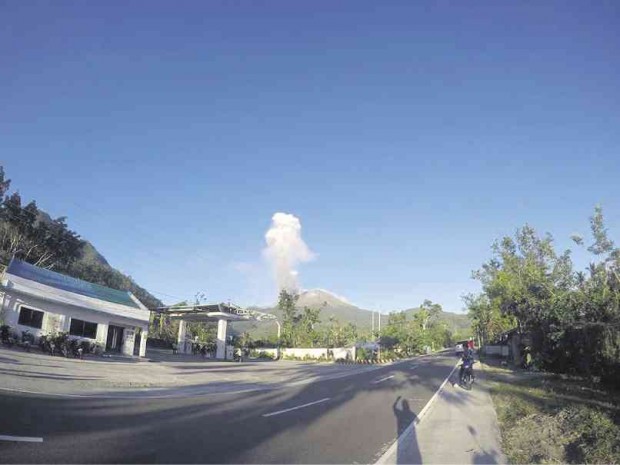
A 500-METER-HIGH ash column belches out of Mount Bulusan in Sorsogon province in this photo taken on Monday afternoon. GLENN OLAYRES BELARMINO/CONTRIBUTOR
LEGAZPI CITY—Mount Bulusan in Sorsogon province spewed out a 500-meter-high ash column on Monday afternoon even as an official of the Philippine Institute of Volcanology and Seismology (Phivolcs) said the volcano had not shown any indication of a major eruption.
Ed Laguerta, Phivolcs resident volcanologist here, said Bulusan had two successive minor explosions that produced a grayish ash plume followed by a steam and ash plume that drifted to the western side of the volcano toward Irosin and Juban towns.
Laguerta said the eruption was of the “phreatic” (steam blast) type, as indicated by steam-driven explosions. It was accompanied by a series of earthquakes that lasted at least four minutes.
A slight “swelling” was observed on the volcano, indicating renewed abnormalities in its condition.
Laguerta said Bulusan remained restive following a series of eruptions starting in June last year.
On Tuesday, the Office of Civil Defense (OCD) in the Bicol region warned the provincial and municipal disaster risk reduction and management councils in Sorsogon to be on alert for sudden eruptions.
Bernardo Rafael Alejandro, OCD regional director, said that while residents living near the volcano need not evacuate, they should be vigilant against the dangers posed by Bulusan’s restiveness.
A team of Phivolcs scientists is conducting a survey to determine if there were significant changes in the volcano’s slopes, Laguerta said in a telephone interview on Tuesday.
A bulletin said the agency’s seismic instruments recorded six volcanic earthquakes after Bulusan’s explosion past 5 p.m. on Monday.
The explosion was accompanied by a rumbling sound heard by residents in the village of Puting Sapa in Juban and the village of Bolos in Irosin, reports reaching Phivolcs said.
Before the eruption, the Bulusan seismic network detected no volcanic earthquake, although increased seismicity was recorded on Feb. 20 and 21.
Traces of volcanic ash were reported in Puting Sapa and the villages of Sagkayon and Caladgao in Juban, and in Bolos in Irosin.
Alert Level 1 (abnormal) remains in effect over Bulusan, indicating that steam-driven eruptions may occur.
Phivolcs and disaster response agencies have reminded local governments and residents that entry into the 4-kilometer radius permanent danger zone is strictly prohibited due to the possibility of sudden eruptions.